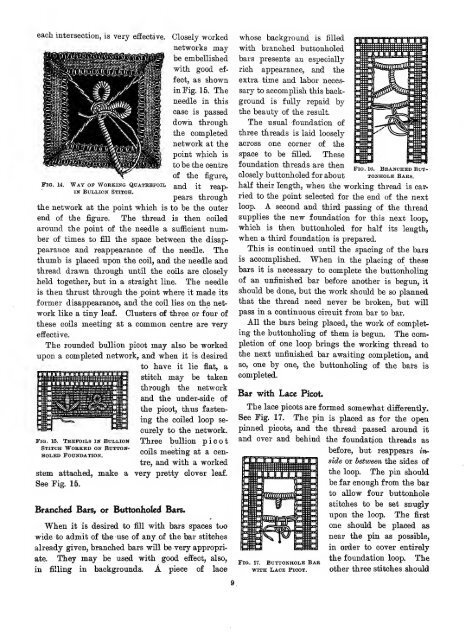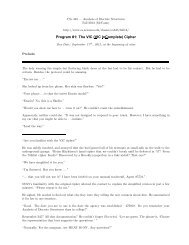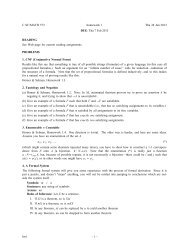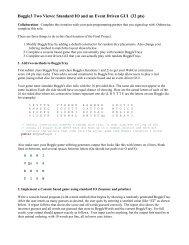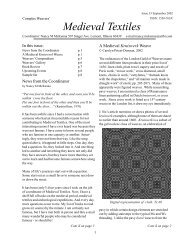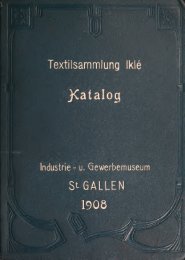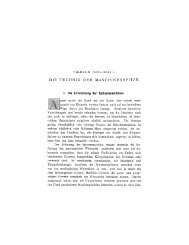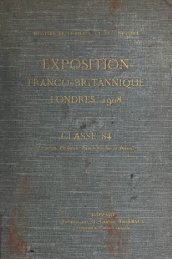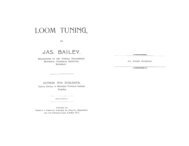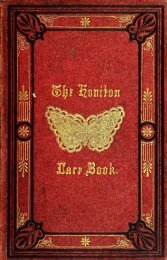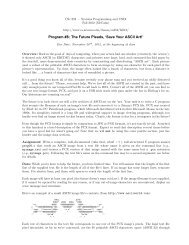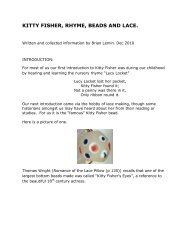The Priscilla Battenberg and point lace book; a collection of lace ...
The Priscilla Battenberg and point lace book; a collection of lace ...
The Priscilla Battenberg and point lace book; a collection of lace ...
Create successful ePaper yourself
Turn your PDF publications into a flip-book with our unique Google optimized e-Paper software.
each intersection, is very effective. Closely worked<br />
networks may<br />
Fig. Way <strong>of</strong> Working QcateeFoil<br />
IN Bullion Stitch.<br />
be embellished,<br />
with good ef-<br />
fect, as shown<br />
in Pig. 15. <strong>The</strong><br />
needle in this<br />
case is passed<br />
down through<br />
the completed<br />
network at the<br />
<strong>point</strong> wjiich is<br />
to be the centre<br />
<strong>of</strong> the figure,<br />
<strong>and</strong> it reap-<br />
pears through<br />
the network at the <strong>point</strong> which is to be the outer<br />
end <strong>of</strong> the figure. <strong>The</strong> thread is then coiled<br />
around the <strong>point</strong> <strong>of</strong> the needle a sufBcient num-<br />
ber <strong>of</strong> times to fill the space between the disappearance<br />
<strong>and</strong> reappearance <strong>of</strong> the needle. <strong>The</strong><br />
thumb is p<strong>lace</strong>d upon the coil, <strong>and</strong> the needle <strong>and</strong><br />
thread drawn through until the coils are closely<br />
held together, but in a straight line. <strong>The</strong> needle<br />
is then thrust through the <strong>point</strong> where it made its<br />
former disappearance, <strong>and</strong> the coil lies on the network<br />
like a tiny leaf. Clusters <strong>of</strong> three or four <strong>of</strong><br />
these coils meeting at a common centre are very<br />
effective.<br />
<strong>The</strong> rounded bullion picot may also be worked<br />
upon a completed network, <strong>and</strong> when it is desired<br />
Fig. 15. Tbefoils in Bullion<br />
Stitch Worked on Buttonholed<br />
Foundation.<br />
stem attached, make a<br />
See Fig. 15.<br />
to have it lie flat, a<br />
stitch may be taken<br />
through the network<br />
<strong>and</strong> the under-side <strong>of</strong><br />
the picot, thus fasten-<br />
ing the coiled loop se-<br />
curely to the network.<br />
Three bullion picot<br />
coils meeting at a cen-<br />
tre, <strong>and</strong> with a worked<br />
very pretty clover leaf.<br />
Branched Bars, or Buttonholed Bars.<br />
When it is desired to fill with bars spaces too<br />
wide to admit <strong>of</strong> the use <strong>of</strong> any <strong>of</strong> the bar stitches<br />
already given, branched bars will be very appropri-<br />
ate. <strong>The</strong>y may be used with good effect, also,<br />
in filling in backgrounds. A piece <strong>of</strong> <strong>lace</strong><br />
whose background is filled<br />
with branched buttonholed<br />
bars presents an especially<br />
rich appearance, <strong>and</strong> the<br />
extra time <strong>and</strong> labor neces-<br />
sary to accomplish this back-<br />
ground is fully repaid by<br />
the beauty <strong>of</strong> the result.<br />
<strong>The</strong> usual foundation <strong>of</strong><br />
three threads is laid loosely<br />
across one corner <strong>of</strong> the<br />
space to be filled. <strong>The</strong>se<br />
foundation threads are then<br />
closely buttonholed for about<br />
Fig. 16. Bkanched Buttonhole<br />
Bars.<br />
half their length, when the working thread is car-<br />
ried to the <strong>point</strong> selected for the end <strong>of</strong> the next<br />
loop. A second <strong>and</strong> third passing <strong>of</strong> the thread<br />
supplies the new foundation for this next loop,<br />
which is then buttonholed for half its length^<br />
when a third foundation is prepared.<br />
This is continued until the spacing <strong>of</strong> the bars<br />
is accomplished. When in the placing <strong>of</strong> these<br />
bars it is necessary to complete the buttonholing<br />
<strong>of</strong> an unfinished bar before another is begun, it<br />
should be done, but the work should be so planned<br />
that the thread need never be broken, but will<br />
pass in a continuous circuit from bar to bar.<br />
All the bars being p<strong>lace</strong>d, the work <strong>of</strong> comJ)let-<br />
ing the buttonholing <strong>of</strong> them is begun. <strong>The</strong> com-<br />
pletion <strong>of</strong> one loop brings the working thread to<br />
the next unfinished bar awaiting completion, <strong>and</strong><br />
so, one by one, the buttonholing <strong>of</strong> the bal-s is<br />
completed.<br />
Bar with Lace Picot.<br />
<strong>The</strong> <strong>lace</strong> picots are formed somewhat differently.<br />
See Pig. 17. <strong>The</strong> pin is p<strong>lace</strong>d as for the open<br />
pinned picots, <strong>and</strong> the thread passed around it<br />
<strong>and</strong> over <strong>and</strong> behind the foundation threads as<br />
before, but reappears in-<br />
side or between the sides <strong>of</strong><br />
the loop. <strong>The</strong> pin should<br />
be far enough from the bar<br />
to allow four buttonhole<br />
stitches to be set snugly<br />
upon the loop. <strong>The</strong> first<br />
one should be p<strong>lace</strong>d as<br />
near the pin as possible,<br />
in order to cover entirely<br />
„ .„ „ „ the foundation loop. <strong>The</strong><br />
Fig. 17. Buttonhole Bab _<br />
^<br />
WITH Lace Picot. other three stitches should


